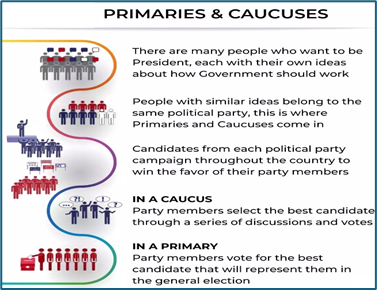Why in news?
The US Presidential Election is set to commence on November 5, with a thrilling race anticipated between Vice President Kamala Harris and former President Donald Trump.
The decisive outcome hinges on the Electoral College, especially in seven key "swing states" where the race remains extremely tight, making the final result uncertain.
What’s in today’s article?
- U.S. Presidential Election
- Electoral College Mechanism in US
- Role of Seven Swing States
U.S. Presidential Election
- Overview
- The U.S. presidential election is held every four years to elect the President and Vice President of the United States.
- It follows an indirect voting process, where citizens vote for a slate of electors who then choose the President and Vice President.
- Constitutional requirements for presidential candidates
- The U.S. Constitution states that the president must:
- Be a natural-born citizen of the United States
- Be at least 35 years old
- Have been a resident of the United States for 14 years
- Primary Elections and Caucuses

- Primaries and caucuses are two ways that people help states and political parties choose presidential nominees.
- These take place in each state and run from early in the election year until the summer.
- During this stage, party members vote for their preferred candidates, and delegates are assigned to represent these choices at the national conventions.
- National Conventions
- Following the primaries, each party holds a national convention where delegates officially nominate the party’s candidates for President and Vice President.
- The nominees then accept the party's nomination, and the general election campaign begins.
- The General Election
- The general election occurs on the first Tuesday after the first Monday in November.
- Voters in each state cast their ballots for President, effectively choosing electors who will represent their state in the Electoral College.
- Electoral College Voting and Inauguration
- In December, the electors meet in their respective state capitals to cast their official votes.
- These votes are counted by Congress in early January, and the President-elect is formally declared.
- The elected President is then inaugurated on January 20, marking the official start of their term in office.
Electoral College Mechanism in US
- Electoral College System
- Americans don't directly vote for the President; instead, they vote for electors who form the Electoral College.
- There are 538 electors, and a candidate needs 270 to win the presidency.
- Allocation of Electors
- Each state has a designated number of electors, roughly based on its population.
- By voting for a candidate, voters are actually choosing that candidate’s party-designated electors for their state.
- Winner-Takes-All Rule
- Most states use a winner-takes-all system (except Maine and Nebraska), where the candidate who wins the popular vote in a state receives all its electoral votes.
- This system often makes the outcome in solidly Democratic or Republican states predictable.
- Importance of Swing States
- Due to this system, close races in a few "swing states" hold significant influence over the election, as the overall outcome depends on who reaches the 270 electoral vote threshold first.
- Duties and voting by electors:
- Electors meet in December to formally vote for the President and Vice President.
- While electors traditionally vote in line with their party's candidate, there is no federal law binding them to do so.
- However, many states have laws enforcing elector loyalty, and faithless electors are rare, as seen in the 2016 election.
Role of Swing States
- Role
- Some states, known as “swing states” or “battleground states,” have historically close races and can vote either Democratic or Republican.
- These states play a pivotal role, as the winner-takes-all system makes their outcome critical to securing the required 270 electoral votes.
- Swing states in this year’s election
- Seven key swing states—Pennsylvania, Georgia, North Carolina, Michigan, Arizona, Wisconsin, and Nevada—are critical in the current U.S. presidential election.
- Together, these states hold 93 Electoral College votes and are being heavily targeted by both Kamala Harris and Donald Trump’s campaigns.










